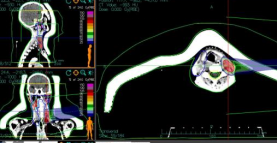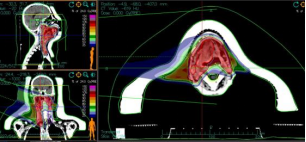Heavy Ion Therapy for Tongue Cancer: A Ray of Hope for Preserving Tongue Function
Heavy Ion Therapy for Tongue Cancer: A Ray of Hope for Preserving Tongue Function
Tongue cancer, as a common oral malignancy, is traditionally treated with surgical resection, radiotherapy, and chemotherapy. However, these methods often result in the loss of tongue function, affecting speech and swallowing abilities, and imposing significant psychological and lifestyle burdens on patients.
Heavy ion therapy, a treatment method that utilizes high-energy heavy ion beams for precise tumor irradiation, offers distinct advantages over traditional radiotherapy. With higher energy and a more focused irradiation range, it can more accurately target tumor cells while minimizing damage to surrounding healthy tissues. In the treatment of tongue cancer, this advantage is particularly significant. Given the critical role of the tongue in daily functions, traditional surgical and radiotherapy methods often cause irreversible damage. In contrast, heavy ion therapy effectively kills cancer cells while preserving the normal structure and function of the tongue. Below is a case of advanced tongue cancer treated with heavy ion therapy, where the patient retained tongue function and achieved effective disease control.
Medical History: A female patient, chief complaint: discovered a mass on the right side of the tongue and tongue base for 6 months.
In January 2024, the patient noticed pain, ulceration, and a localized mass on the right side of the tongue, accompanied by local pain, swelling, surface ulceration, and fluid discharge. The tumor gradually increased in size. On July 18, 2024, a biopsy of the tongue mass was performed, with pathological results indicating moderately differentiated squamous cell carcinoma of the right side of the tongue. Maxillofacial and neck MRI revealed a mass in the tongue and right tongue base with abnormal enhancement, likely invasion of the adjacent soft palate, orbicularis oris muscle, and right epiglottis, with narrowing of the laryngopharyngeal cavity at the same level. Enlarged lymph nodes in the right cervical vascular space were observed, suggesting metastasis. The patient was definitively diagnosed with squamous cell carcinoma of the tongue, cT4aN2bM1, stage IVC. After comprehensive evaluation of the condition and clinical staging, carbon ion therapy was initiated on July 30, 2024, with nutritional support. The treatment plan included GTV: 64Gy (RBE)/17Fx, CTV1: 60Gy (RBE)/15Fx, and CTV2: 56Gy (RBE)/14Fx. The entire treatment was successfully completed.


Figure 1. Carbon ion therapy plan: GTV: 64Gy (RBE)/17Fx, CTV1: 60Gy (RBE)/15Fx, CTV2: 56Gy (RBE)/14Fx.

Figure 2: Pre-treatment MRI: A mass in the tongue and right tongue base (4.1x8.4cm) with abnormal enhancement, likely invasion of the adjacent soft palate, orbicularis oris muscle, and right epiglottis, with narrowing of the laryngopharyngeal cavity at the same level.

Figure 3: Post-treatment MRI: A mass in the tongue and right tongue base (4.1x2.1cm), showing a reduction in size compared to previous imaging. Clinical evaluation: PR (Partial Response).
Tongue cancer is a common malignant tumor in the oral and maxillofacial region, with a higher incidence in males than in females. Over 98% of cases are squamous cell carcinoma, particularly in the anterior two-thirds of the tongue. The primary treatment for tongue cancer is surgical intervention. Early-stage tongue cancer can often be effectively treated with surgery alone, as the cancerous area is small, requiring limited resection and preserving more healthy tissue, thereby minimizing impacts on eating, swallowing, and speech. For cervical lymph node dissection, prophylactic neck dissection is typically employed, which is more limited in scope and has fewer side effects.
In advanced-stage tongue cancer, a combination of surgery, radiotherapy, and chemotherapy is necessary. Due to the larger extent of cancer in advanced cases, more tissue must be removed during surgery, potentially resulting in the loss of half or more of the tongue, or even total glossectomy. Neck lymph node dissection also becomes more challenging, with a broader scope and higher risks. Post-surgery, radiotherapy and chemotherapy are administered based on the patient’s condition.
Carbon ion radiotherapy (CRIT) is an emerging treatment method in the 21st century. Compared to traditional X-ray radiotherapy, carbon ion therapy offers significant advantages in treatment efficacy and is internationally recognized as a leading cancer treatment modality. It boasts high precision, fewer side effects, minimal damage to surrounding healthy tissues, high cure rates, and shorter treatment durations. Due to the high energy and strong destructive power of carbon ions, they can precisely target and destroy tumor cells while sparing adjacent normal tissues. This makes carbon ion therapy particularly effective in treating certain types of tumors, especially deep-seated tumors and those near critical organs.
In the case of the aforementioned tongue cancer patient, recent efficacy evaluation after carbon ion therapy showed partial remission, with significant symptom improvement, mild side effects, and good tolerance. This further confirms the effectiveness and safety of carbon ion radiotherapy in the treatment of tongue cancer.
